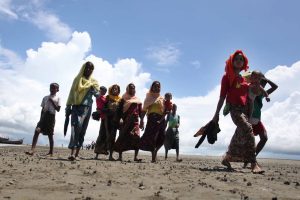The bodies of 14 people have washed up on a beach in western Myanmar, after a boat carrying Rohingya refugees capsized while attempting to reach Malaysia. In an article yesterday, AFP quoted a police official in the southwestern township of Pathein as saying that 35 people had also been rescued after the sinking.
The tragedy was confirmed by the United Nations High Commissioner for Refugees (UNHCR), which said in a statement yesterday that the boat was believed to have left Sittwe in Rakhine State on May 19. It encountered bad weather, causing it to capsize near the coast of Pathein township two days later. UNHCR said that at least 17 people were feared dead.
“The latest tragedy shows once again the sense of desperation being felt by Rohingya in Myanmar and in the region,’’ Indrika Ratwatte, UNHCR’s director for Asia and the Pacific said in the statement. “It is shocking to see increasing numbers of children, women and men embarking on these dangerous journeys and eventually losing their lives.”
For nearly five years, more than 1 million mostly Muslim Rohingya civilians have been enclosed in the rambling refugee camps that surround the town of Cox’s Bazar in southeastern Bangladesh. Most fled their homes in Rakhine State, western Myanmar after August 2017, when Myanmar’s armed forces launched a brutal “clearance operation” in response to scattered attacks by Rohingya militants. The offensive, which the U.N. later claimed showed “genocidal intent,” saw soldiers and vigilantes torch villages, shoot civilians, and drive an estimated 750,000 desperate people over the border into Bangladesh, joining a smaller number who had fled the country during earlier ethnic and sectarian pogroms.
Since then, the humanitarian crisis has persisted without any clear prospect of a resolution. The favored outcome – voluntary repatriations of Rohingya refugees to their former villages in western Myanmar – has never gotten off the ground due to the inhospitable political conditions inside the country.
While a solution was remote even before the coup, the new crisis has further compounded their troubles, complicating any resolution to the refugee emergency, while also distracting international attention away from what might be done to resolve it. The fierce fighting between the Myanmar military and the Arakan Army in 2018-20 created another obstacle to voluntary repatriations.
The Bangladeshi government, eager to free itself of the burden of caring for such a large refugee population, has created plans to relocate 100,000 Rohingya to Bhasan Char, a wind-swept island in the Bay of Bengal. Around 24,000 have so far been relocated there, amid allegations of coercion and inadequate facilities and resources on the island.
All of these challenges have simply been compounded by the military coup of February 2021, which has produced a state of generalized conflict across the country. This has complicated any resolution to the refugee emergency, while also taxing the finite attention and resources of the U.N. and supportive foreign governments
As this week’s tragic sinking shows, with little prospect of any improvement in their lot, thousands of others are clearly desperate enough to embark on leaky vessels in an attempt to reach safe havens in Malaysia or Indonesia. As long as the crisis festers, it is a harrowing reality that many will continue to wager that the great financial cost and personal risk is worth the chance of a better life.

































